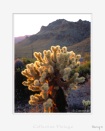
The Joshua tree (Yucca brevifolia) is a monocotyledonous tree native to southwestern North America, in the states of California, Arizona, Utah and Nevada. Confined mostly to the Mojave Desert between 400-1,800 m (2,000-6,000 feet), they thrive in the open grasslands of Queen Valley and Lost Horse Valley in Joshua Tree National Park.
Joshua trees can grow from seed or from an underground rhizome of another Joshua tree. They are slow growers; new seedlings may reach a height of 10-20 cm in their first few years, then only grow about 10 cm per year thereafter. The trunk of a Joshua tree is made of thousands of small fibers and lacks annual growth rings, making it difficult to determine the tree's age. This tree is not very sturdy because of its shallow root area and top-heavy branch system, but if it survives the rigors of the desert it can live to two hundred years of age. The tallest trees reach about 15 m tall.
The leaves are dark green, linear, bayonet-shaped, 15-35 cm long and 7-15 mm broad at the base, tapering to a sharp point; they are borne in a dense spiral arrangement at the apex of the stems. The leaf margins are white and serrate.
 The flowers are produced in spring from February to late April, in
panicles 30-55 cm tall and 30-38 cm broad, the individual flowers erect,
4-7 cm tall, with six creamy white to green tepals. The tepals are lanceolate
and are fused to the middle. The fused pistils are 3 cm tall and the
stigma cavity is surrounded by lobes. The fruit that is produced is
green-brown, elliptical, and contains many flat seeds. Joshua trees
usually do not branch until after they bloom (though branching may also
occur if the growing tip is destroyed by the yucca-boring weevil), and
they do not bloom every year. Like most desert plants, their blooming
is dependent on rainfall at the proper time. They also need a winter
freeze before they will bloom
The flowers are produced in spring from February to late April, in
panicles 30-55 cm tall and 30-38 cm broad, the individual flowers erect,
4-7 cm tall, with six creamy white to green tepals. The tepals are lanceolate
and are fused to the middle. The fused pistils are 3 cm tall and the
stigma cavity is surrounded by lobes. The fruit that is produced is
green-brown, elliptical, and contains many flat seeds. Joshua trees
usually do not branch until after they bloom (though branching may also
occur if the growing tip is destroyed by the yucca-boring weevil), and
they do not bloom every year. Like most desert plants, their blooming
is dependent on rainfall at the proper time. They also need a winter
freeze before they will bloom
Once they bloom, the trees are pollinated by the yucca moth, which spreads pollen while laying her eggs inside the flower. The moth larvae feed on the seeds of the tree, but enough seeds are left behind to produce more trees. The Joshua tree is also able to actively abort ovaries in which too many eggs have been laid. (Source Wikipedia)
© 1998-2026 - C. Cassegrain Photograph - All rights reserved v.01 - Mobile : +33 6 71 26 04 76 |